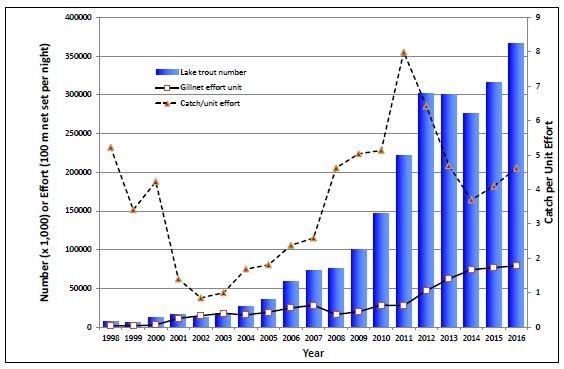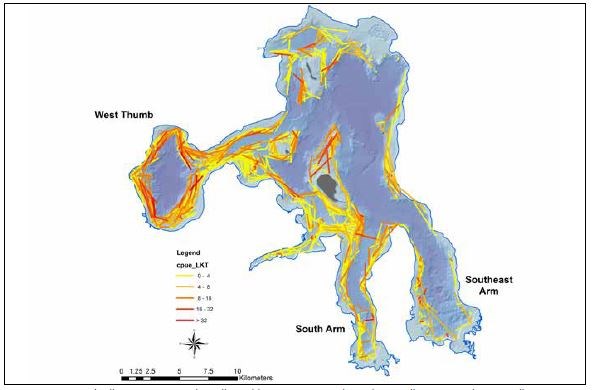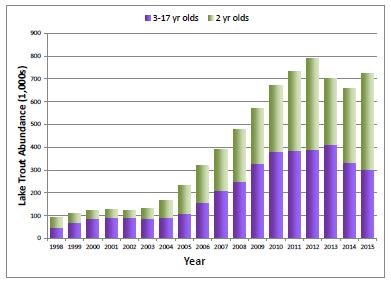Part of a series of articles titled Yellowstone Science - Volume 25 Issue 1: Native Fish Conservation.
Article
Suppressing Non-native Lake Trout to Restore Native Cutthroat Trout in Yellowstone Lake

NPS Photo - S. Sigler
from Yellowstone Science 25(1)
by Patricia E. Bigelow, Philip D. Doepke, Brian D. Ertel, Christopher S. Guy, John M. Syslo, & Todd M. Koel
The suppression of lake trout via netting has been ongoing in Yellowstone Lake since 1994 when this non-native species was first discovered. Twenty-two years later, we continue to catch large numbers of lake trout. So, why should lake trout suppression be maintained, what’s the science behind it, and what’s the prognosis for the future? This article provides information about why lake trout are detrimental in Yellow stone Lake, reviews past suppression efforts, describes where the program is now, and reflects on the future of lake trout suppression and Yellowstone cutthroat trout recovery.Background
Yellowstone Lake is home to the largest population of Yellowstone cutthroat trout in existence. This population plays a critical role in the ecosystem, transporting nutrients from lake waters to tributary streams during spawning and to the terrestrial (land) system when the fish are eaten by birds and mammals (see “Birds and Mammals that Consume Yellowstone Cutthroat Trout,” this issue; Crait and Ben-David 2006). Also, cutthroat trout have a predominant influence on the structure of the lake community, including zooplankton and phytoplankton (see “Non-native Lake Trout Induce Cascading Changes in the Yellowstone Lake Ecosystem,” this issue; Tronstad et al. 2010). They have provided a world-renown angling opportunity for more than a century, drawing anglers from around the globe and contributing $36 million annually to local economies (Varley and Schullery 1995).Lake trout, however, are voracious, efficient predators that frequently live 20-25 years and are able to reach large sizes—the Wyoming state record for a lake trout is approximately 23 kg (50 lb.; Martinez et al. 2009). Their large size enables them to produce thousands of eggs annually, which leads to rapid population growth and an expanding distribution. Lake trout can consume cutthroat trout up to one-third their own size. Although lake trout need energy-rich prey such as cutthroat trout to continue to grow, they can persist for years with minimal food resources due to their cold-blooded nature. For example, in a reservoir in Colorado, tagged lake trout persisted for over 10 years after the loss of kokanee salmon, their preferred prey, though most of these fish had not grown since release (Martinez et al. 2009).
These traits make it possible for lake trout to have drastic impacts on ecosystems outside their native range. Given their long lives, ability to eat large prey, efficient predatory skills, and ability to persist on a variety of foods, lake trout not only deplete native species, but also persist at levels that keep native populations suppressed. Thus, when a 43 cm (17 in.) lake trout was caught in Yellowstone Lake in 1994, fishery professionals and park managers realized they had a serious problem. Non-native lake trout could decimate the native cutthroat trout population and then, due to their cold-blooded nature, persist at high numbers on other foods preventing their preferred prey (cutthroat trout) from recovering. Lake trout readily consume foods cutthroat trout historically subsisted on in Yellowstone Lake. In addition to killing cutthroat trout, lake trout could reduce the cutthroat trout’s food base, thereby making cutthroat trout recovery impossible until the lake trout population is suppressed.
Initial Efforts to Suppress Lake Trout
After confirming lake trout were successfully reproducing in Yellowstone Lake (Varley and Schullery 1995, Kaeding et al. 1996), the National Park Service (NPS) convened a panel of expert scientists to determine the likely extent of the problem, recommend actions, and identify research needs. The panel concluded the suppression of lake trout was necessary to protect and restore native cutthroat trout, but would require a longterm, possibly perpetual, commitment. The panel also indicated direct removal efforts, such as gillnetting or trap netting, would likely be most effective (McIntyre 1995). As a result, research on lake trout movements, spawning, diet, and abundance was initiated (Ruzycki et al. 2003). Early removal efforts were expanded in 2001 using a Great Lakes-style gillnetting boat, miles of gillnets, and personnel specifically hired to gillnet lake trout through summer (June through mid-October). These efforts increased the amount of gillnet fishing for lake trout more than 10-fold. In response, the number of lake trout removed from the population doubled, and incidental catch of native cutthroat trout was greatly reduced by fishing deeper waters not typically used by cutthroat trout (Bigelow et al. 2003).Over time, fishery biologists learned more about the best ways to detect and target lake trout. In spite of this, increased gillnetting effort continued to result in increased catch, suggesting the lake trout population was continuing to grow (figure 1). Thus, Yellowstone National Park (YNP) managers decided an in-depth review and reevaluation of the direction of the program was needed. In 2008, 15 experts were convened to evaluate the suppression program and recommend future actions. Although the lake trout population had continued to expand (Syslo et al. 2011), the panel concluded netting remained the most viable option for suppressing the population. Yet, they also indicated a considerable increase in suppression effort would be needed over many years to collapse the lake trout population (Gresswell 2009). In addition to maintaining the number of NPS staff dedicated to the program, the panel recommended contracting commercial fishermen to substantially increase effort and efficiency (Gresswell 2009). If commercial fishing could collapse lake trout populations in many of the Great Lakes, it could work in Yellowstone Lake.

Filling the Data Gaps
Following this intensive review, YNP expanded monitoring, launched a pilot program to determine if commercial fisherman could increase catch of lake trout, and initiated more in-depth research to estimate lake trout abundance and predict the level of suppression needed to collapse the population. A goal was set to reduce the abundance of lake trout to mid-1990s levels, when it’s likely relatively few lake trout impacted the native cutthroat trout population (Koel et al. 2010). However, a major uncertainty was the amount of netting pressure needed to induce such a substantial decrease in lake trout abundance. Population modeling and analyses of lake trout removals were used to address this question and to assess the suppression program’s success. Three important metrics were assessed for lake trout: total annual mortality in the population, abundance, and population growth rate.A catch-at-age analysis based on the age structure of the total catch of lake trout removed by the suppression program, and the effort used to do so each year, was conducted to estimate lake trout mortality and abundance. Randomly selected sites dispersed throughout the lake were sampled via gillnetting to obtain an independent estimate of mortality conducted separately from suppression netting efforts (see “Cutthroat Trout Response to Suppression of Lake Trout,” this issue). In addition, a model based on mortality and several other population descriptors (e.g., length at age, survival and fecundity of females at each age, probability of maturity, survival of young until large enough to be captured in the nets) was developed to estimate the change in population growth rate associated with changes in total netting effort (Syslo et al. 2011). This model also estimates the amount of netting effort needed to achieve a population decrease. In combination, the analyses and modeling results provide rigorous estimates of how successful the program has been at decreasing lake trout in Yellowstone Lake.
Increased Efforts to Suppress Lake Trout
Multiple scientific reviews stressed that substantial suppression of lake trout was necessary for the cutthroat trout population to recover. In 2012, removal efforts were increased dramatically in order to drive the lake trout population growth rate from one that had been increasing for over a decade to one that is decreasing (Syslo et al. 2011, Gresswell et al. 2012). Hickey Brothers Research, LLC, a company with roots in commercial fishing on Lake Michigan, was tasked with the bulk of the suppression work, operating three full-time boats designed specifically for gillnetting. Crews work six days per week from late May into early October, with each crew setting and retrieving 60 nets per day. Letting each net soak, or catch fish, for 3-4 nights allows each crew to handle 180 nets twice a week.
In 2013, we conducted a mark-recapture study to validate population estimates and obtain an independent estimate of the annual exploitation rate (the percentage of the population, or given age/size class, removed) in a given year. A large number of lake trout (2,400) were captured, marked with numbered tags (monofilament inserted between the bones of the dorsal fin with a T-bar similar to clothing tags), and released. Tagged fish later caught in suppression nets or via angling were documented and used to estimate the number of lake trout present in the lake; the derived estimate was 367,650 fish greater than 210 mm (8.3 in.) long. The mark-recapture study also enabled an estimate of the probability of capture for four size classes.
In 2013, 69% of tagged fish were recaptured by netting or anglers. Estimated exploitation rates were 72% for lake trout 210-451 mm (8.3-17.8 in.) in length, 56% for fish 451-541 mm (17.8- 21.3 in.) long, 48% for fish 541-610 mm (21.3-24.0 in.) long, and 45% for fish more than 610 mm (more than 24.0 in.) long (Gresswell et al. 2015). These results supported previous estimates and highlight the difficultly in catching older, larger lake trout which eat the most cutthroat trout. Older, larger lake trout also have the highest reproductive success.
Lake Trout Response to Increased Suppression Efforts
In 2016, we experienced our highest lake trout suppression effort, along with the highest number of lake trout removed, to-date (figure 1). Catch per unit effort remained relatively low, indicating crews had to work harder and smarter to catch the same number of fish. Increases in catch and catch per unit effort can reflect increased efficiency, increased abundance, or both. Improvements in fishing gear, increased knowledge of how lake trout use the ecosystem, and experienced personnel can lead to increases in catch and catch per effort despite a decreasing population. Hence, independently monitoring the effectiveness and results of suppression activities, as well as updating population models, is an important aspect of the program. Models have shown the lake trout population continued to expand through at least 2011, but increased netting since then has begun to reduce lake trout numbers and biomass (total weight) in Yellowstone Lake. Abundance estimates for lake trout age 2 and older indicate a cessation of population growth and a decrease in fish older than 2 years (figure 3). As this continues, the reproductive and expansion potential of the population will be reduced, greatly aiding overall suppression. Also, total annual mortality rates have been steadily increasing over the last several years and have exceeded 50% in two of the last three years, which should decrease the population size. In addition, the total biomass of lake trout removed has been well above what is considered a sustainable harvest (0.5 kg per ha) for the last several years.
Future Outlook
The magnitude of the lake trout problem in Yellowstone Lake remains enormous. Lake trout have had several decades to expand throughout the lake and pioneer several spawning areas. Yellowstone Lake provides near-perfect spawning and rearing habitat for lake trout with few natural predators present. Lake trout are longlived, and one individual female can produce thousands of eggs each year. The survival of young lake trout in the lake is estimated to be 2.5 times higher than in its native range (Syslo 2015). Even without cutthroat trout, other foods in Yellowstone Lake would support a large lake trout population. Reducing the lake trout population to a level that will have only minor impacts to the cutthroat trout population is predicted to take until at least 2025, provided we maintain current high levels of suppression effort. Given the high reproductive potential of this lake trout population, we will regress immediately and likely dramatically if we reduce the amount of suppression effort applied without adequate alternative techniques (see “Lake Trout Suppression Alternatives to Gillnetting,” this issue).Compared to other lakes invaded by lake trout in the West, Yellowstone Lake has a relatively simple fish assemblage. Only two species, cutthroat trout and lake trout, occupy the vast majority of the habitat; however, they segregate into different depths or water temperatures of the lake most of the time. Thus, the solution is deceptively simple: decimate the lake trout population while not adversely impacting Yellowstone cutthroat trout. Reviews of the program over multiple years by multiple fishery scientists, along with in-depth population modeling, continue to emphasize this resource issue can be solved given sufficient suppression effort. In fact, recent monitoring suggests both the abundance of older lake trout and the biomass of lake trout removed has been decreasing since 2012. With planned increases in suppression netting for 2017 coupled with emerging technology for killing lake trout eggs and embryos, a population crash is expected to happen sooner than population models suggest. However, until new methods can be verified, netting suppression of lake trout in Yellowstone Lake must continue and is widely supported by anglers, fishery experts, and park managers. Thus, suppression efforts will continue in an attempt to restore a robust native Yellowstone cutthroat trout population in Yellowstone Lake.
Literature Cited
Bigelow, P.E., T.M. Koel, D. Mahony, B. Ertel, B. Rowdon, and S.T. Olliff. 2003. Protection of native Yellowstone cutthroat trout in Yellowstone Lake, Wyoming. Technical Report NPS/NFWRD/ NRTR-2003/314. Yellowstone National Park, Wyoming, USA.Crait, J.R., and M. Ben-David. 2006. River otters in Yellowstone Lake depend on a declining cutthroat trout population. Journal of Mammalogy 87:485-494.
Gresswell, R.E. 2009. Scientific review panel evaluation of the National Park Service lake trout suppression program in Yellowstone Lake, August 25-29. Final report. YCR-2009-05. U.S. Geological Survey, Northern Rocky Mountain Science Center, Bozeman, Montana, USA.
Gresswell, R.E., P. Budy, C.S. Guy, M.J. Hansen, M.L. Jones, P.J. Martinez, C. Suski, and J.E. Williams. 2012. Confronting a lake trout invasion of Yellowstone Lake: an interim scientific assessment, June 14-16, 2011. A report to the superintendent of Yellowstone National Park. YCR-2012-04. U.S. Geological Survey, Northern Rocky Mountain Science Center, Bozeman, Montana, USA.
Gresswell, R.E., C.S. Guy, M.J. Hansen, M.L. Jones, J.E. Marsden, P.J. Martinez, and J.M. Syslo. 2015. Lake trout suppression in Yellowstone Lake: science review panel. Interim scientific assessment, 2014 performance year. A report to the superintendent. YCR-2015-04. National Park Service, Yellowstone National Park, Wyoming, USA.
Kaeding, L.R, G.D. Boltz, and D.G. Carty. 1996. Lake trout discovered in Yellowstone Lake threaten native cutthroat trout. Fisheries 21:16-20.
Koel, T.M., J.A. Arnold, P.E. Bigelow, and M.E. Ruhl. 2010. Native lake trout conservation plan. Environmental assessment, December 16, 2010. National Park Service, Yellowstone National Park, Wyoming, USA.
Martinez, P.J, P.E. Bigelow, M.A. Deleray, W.A. Fredenberg, B.S. Hansen, N.J. Horner, S.K. Lehr, R.W. Schneidervin, S.A. Tolentino, and A.E. Viola. 2009. Western lake trout woes. Fisheries 34:424-442.
McIntyre, J.D. 1995. Review and assessment of possibilities for protecting the cutthroat trout of Yellowstone Lake from introduced lake trout. Pages 28-36 in J.D. Varley and P. Schullery, editors. The Yellowstone Lake crisis: confronting a lake trout invasion. A report to the director of the National Park Service. Yellowstone National Park, Mammoth, Wyoming, USA.
Ruzycki, J.R., D.A. Beauchamp, and D.L. Yule. 2003. Effects of introduced lake trout on native cutthroat trout in Yellowstone Lake. Ecological Applications 13:23-37.
Syslo, J.M., C.S. Guy, P.E. Bigelow, P.D. Doepke, B.D. Ertel, and T.M. Koel. 2011. Response of non-native lake trout (Salvelinus namaycush) to 15 years of harvest in Yellowstone Lake, Yellowstone National Park. Canadian Journal of Fisheries and Aquatic Science 68:2132-2145.
Syslo, J.M. 2015. Dynamics of Yellowstone cutthroat trout and lake trout in the Yellowstone Lake ecosystem: a case study for the ecology and management of non-native fishes. Dissertation. Montana State University, Bozeman, Montana, USA.
Tronstad, L.M, R.O. Hall, Jr., T.M. Koel, and K.G. Gerow. 2010. Introduced lake trout produced a four-level trophic cascade in Yellowstone Lake. Transactions of the American Fisheries Society 139:1536-1550.
Varley, J.D., and P. Schullery. 1995. Socioeconomic values associated with the Yellowstone Lake cutthroat trout. Pages 22-27 in J.D. Varley and P. Schullery, editors. The Yellowstone Lake crisis: confronting a lake trout invasion. A report to the director of the National Park Service. Yellowstone National Park, Wyoming, USA.
______________________________________________________________________
Patricia Bigelow has worked in fisheries for over 34 years, 20 of those in Yellowstone National Park. She currently focuses on suppression of the non-native lake trout in Yellowstone Lake in defense of the Yellowstone cutthroat trout. She obtained her PhD from University of Wyoming, modeling potential lake trout spawning habitat in the lake.
Last updated: August 2, 2017
